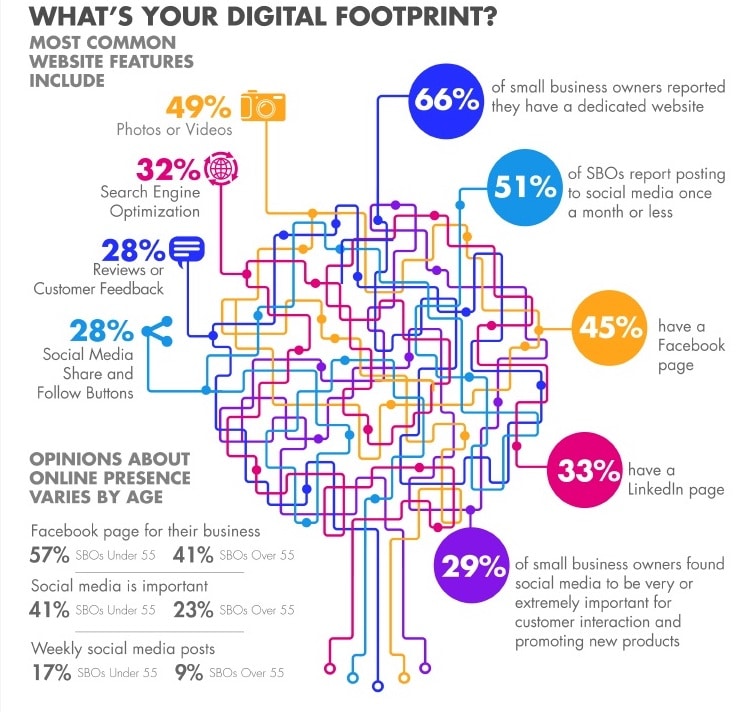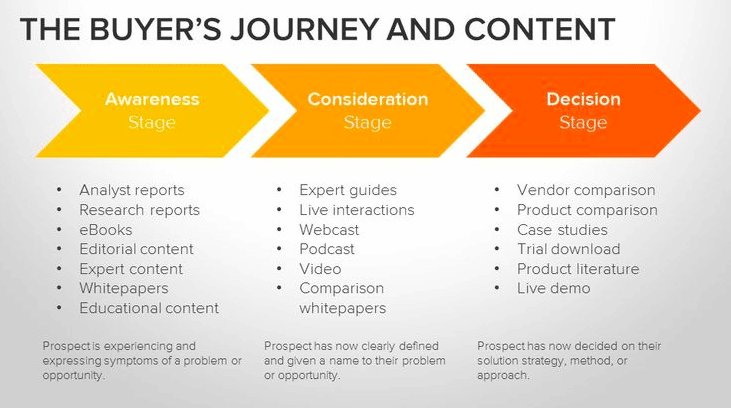No matter where you are in your entrepreneurial journey, you’ve probably heard that content is king. There are a LOT of reasons for this:
- Content marketing costs about 62% less than traditional marketing.
- Conversion rates are nearly 6 times higher for those who use content marketing vs. those who don’t.
- 69% of marketers agree that content marketing is superior to direct mail (and other conventional marketing techniques).
How strong is your content marketing game? And more importantly, how can you use all the content you create to supercharge your lead gen strategy?
Here’s an overview of what a great content marketing strategy looks like when applied to lead gen:
Step 1: Build Your Digital Footprint
This first step is often treated like a last-minute afterthought, but when you’re using content marketing to generate leads, you can’t afford to overlook the value of your digital footprint. Before you start creating your lead magnets and content, you first need to look at your online presence. Without a strong digital footprint, your lead magnets aren’t likely to pay off in any significant way.

Your digital footprint is the combination of all of your online channels, branding, and presence: social media accounts, blogs, websites, guest blogs or content, mentions, and reviews, among others.
Here’s why this is important:
When you create a lead magnet, you’re essentially asking your prospects to trade something in exchange for content. It could be an email address. It might be a dollar. Whatever it is, not everyone will be so eager to hand over their info without first checking you out. They want to know if you’re the “real deal,” so they may head to Google to learn more about you.
If they can’t find anything (or at least anything that supports your credibility), do you think they’re going to convert?
At the very least, build up your LinkedIn profile, post a few blogs, and have your own website. You can also add a Facebook page and ask a few friends or colleagues for Google reviews to help you start adding credibility to your name.
Step 2: Know Your Ideal Customer
Once you have a digital foundation, you can start creating your lead magnets. An effective lead magnet has two priorities: it relates to what you do AND it relates to the type of customer you want to buy from you. Both of these priorities are essential if you want your lead magnet to work.
You already know what you do best, so focus on creating your customer avatar. This is a fictional profile that represents real buyers in your market and should include the following:
- Values (what they care about)
- Pain points (ideally the ones you can solve)
- Buying role
- Objections or obstacles in making a purchase
- Ways they might discover you (e.g. social media networks, ads, blogs, etc.)
To learn more about your ideal customer, you can use online tools like Quantcast or MyBestSegments.
Step 3: Choose the Right Content Format
Content marketing comes in all shapes and formats, including but not limited to:
- Ebooks
- Checklists
- How-to Guides
- Blogs
- Guest Blogs
- Videos
- White papers
- Webinars
(There’s a lot you can add to this list.)
I recommend using a format that caters to the prospect in wherever they are in the buyer’s journey. If you’re generating leads, chances are they will be in the Awareness stage, so a blog, video, or downloadable asset is usually a good format choice.

Step 4: Create Content that Addresses Your Customers’ Needs
Lead gen content marketing isn’t just about showing people what you can do and getting them on your email list. It’s about giving them a reason to care about what you do and showing them how you can help them. You’ll develop your lead gen content marketing around the “know your customer” discovery process found in Step 2.
For example, let’s say you’re a freelance digital marketer and you want to work with small businesses. You realize that many small businesses may not think they can afford to hire someone to do their marketing, which is why many of them do it in-house. However, they’re likely not great at marketing, especially when they have a business to run.
Knowing what you bring to the table and the challenges your customers face, you can develop content that addresses these attributes. A lead magnet could be a downloadable asset on “X ways to save time and money on marketing” or “X things small businesses get wrong about digital marketing.” These things will likely matter to a small business that is short on time and money and isn’t sure if their marketing is effective.
Remember, the goal isn’t to sell them on your services. It’s simply to get the information of people most likely to need what you’re offering so that you can nurture those leads into paying customers.
Step 5: Optimize Content Using Search Intent
So far, we’ve covered some of the basics of building a lead magnet. Now, let’s really supercharge those efforts by optimizing your content based on intent.
If you’re wanting people to find your content online, you need to consider the intent behind the way people search. Intent refers to the reasons why people are searching, and this typically takes three forms:
- To buy
- To learn
- To find
Commercial keywords can help you filter out people who are searching for information that doesn’t relate to what you offer. For example, if you’re a productivity coach and your lead magnet or content is “X Hacks to Working from Home with Kids,” then you wouldn’t want to use vague keywords like “work from home” or “home hacks.” Otherwise, your content is going to be competing with work-from-home job postings and Marie Kondo-like blog posts.

You can use tools like Google Keyword Planner or UberSuggest to find long-tail keywords that are more specific to your user’s search intent.
Wrapping It Up
When you focus on content quality and not just creating content for the sake of content, you’ll be much more likely to make real connections with your target audience showing them why you’re a great choice for business.
Always remember that good content isn’t sales-y — your goal should be to establish yourself as an expert by providing truly helpful insights to your ideal customers. Once they see the value you bring to the table, they are more likely to be responsive as you nurture them from a qualified lead into a sale.
For more insights, head back to my blog.






2 Responses